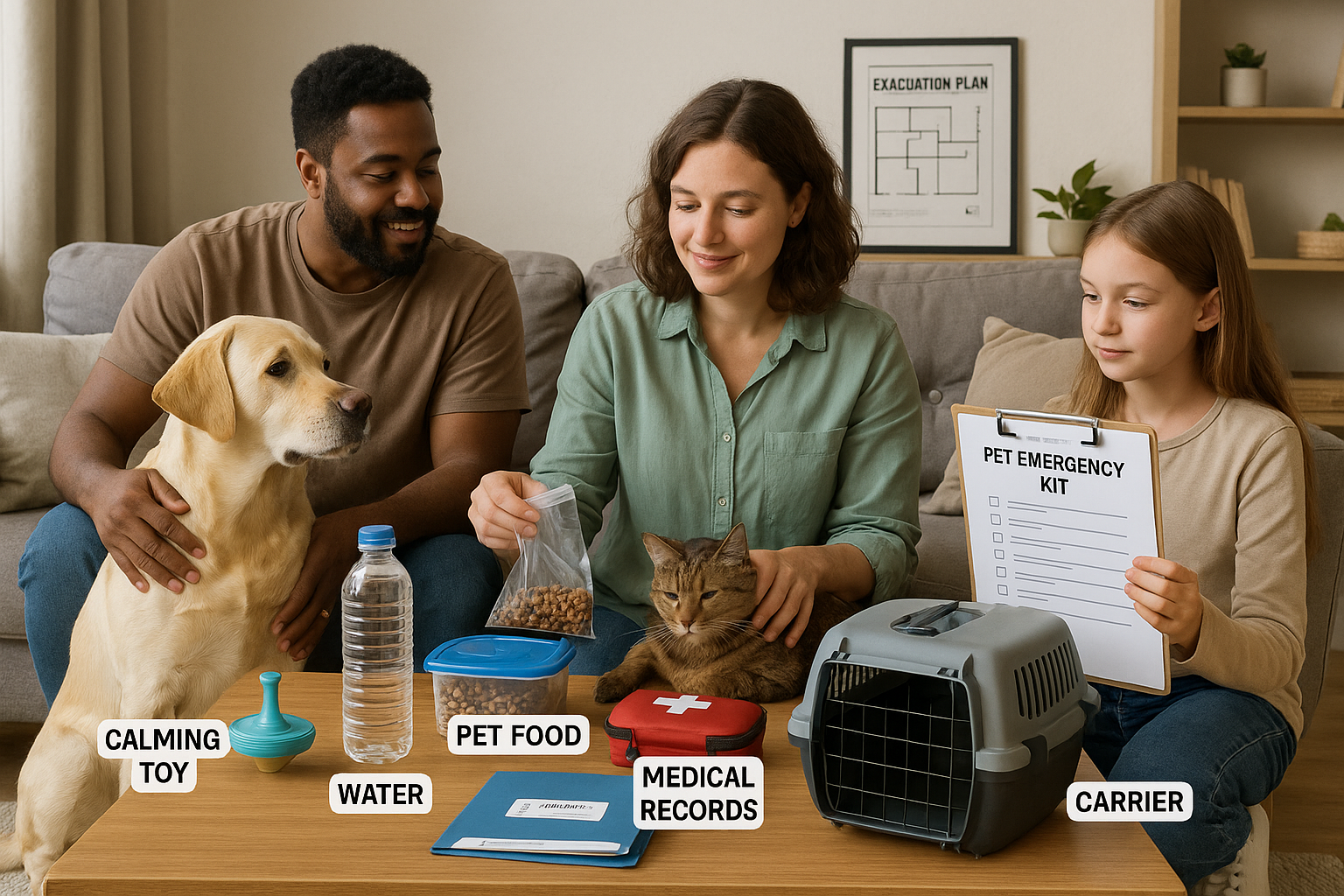When a natural disaster threatens, most people focus on food, water, and shelter. Pets are often left as an afterthought. For animal lovers, pets are family. They depend on us to keep them sheltered and safe. Pet disaster preparedness goes beyond simply grabbing a leash in a hurry. It involves thoughtful planning, detailed preparation, and a commitment to your animals’ well-being. This article guides you through emergency strategies tailored for pets, essential gear to have ready, and expert advice on how to keep your animals calm during chaotic events.
Why Pet Disaster Preparedness Matters
Pets cannot advocate for themselves in emergencies. Hurricanes, wildfires, floods, or tornadoes can upend routines, scatter families, and destroy homes without warning. Amid panic, pets might go missing or face life-threatening conditions. Some emergency shelters may not accept animals. Situations like these highlight why disaster readiness must include pets. Neglecting to plan for animals may put them and owners at risk. Stress can make pets unpredictable and difficult to manage, especially when chaos reigns outside.
Making a Detailed Pet Emergency Plan
Your pet emergency plan starts with information. Know which disasters are common in your region. Wildfires and earthquakes pose different risks than hurricanes or blizzards. Create a list with essential contact information for veterinarians, local animal shelters, animal control, and emergency clinics. Save this digitally and print it for your emergency kit. Notify your veterinarian and neighbors about your plan.
Evacuations often happen without warning. Before a crisis, identify pet-friendly accommodations, including hotels, boarding facilities, and emergency shelters nearby. Many hotels or motels relax their animal policies during disasters, but others will not. Call ahead and verify pet policies for each site you might go to, keeping addresses and phone numbers ready on paper and phone. Include close friends or relatives who could temporarily house your pet.
Use a buddy system with neighbors or friends. Identify someone reliable nearby who can access your home and care for your pets if you cannot get home. Leave them spare keys along with clear feeding and medication instructions. Confirm they feel comfortable handling your animals and have met them before. Share your evacuation destination with this trusted person.
Identification keeps animals from being lost forever if you become separated. Make sure pets wear collars with visible, up-to-date tags showing your name, phone, and address. Microchipping increases the odds of reunion if tags are lost. Double-check that each microchip is registered with current contact information.
Assembling a Pet Emergency Kit
Your emergency kit will be the foundation of your pet disaster preparedness. Get a waterproof, sturdy bag or plastic bin dedicated to pet supplies. Place it somewhere you can grab at a moment’s notice.
First, pack enough food to last at least two weeks. Choose shelf-stable foods that your pet eats regularly. Rotate food supplies every few months to keep them fresh. Use air-tight, waterproof containers. Include a manual can opener if needed for canned food. Bring at least two weeks’ supply of bottled water, separate from your own.
Pets depend on routine medications just as much as people. Store an extra two weeks’ worth of any prescription or over-the-counter medicine your animal needs. Some common examples include flea or tick preventives, heartworm pills, and daily medications for chronic illness or allergies. Attach written details about dosages and administration times.
Medical records matter during disasters. You may need to prove rabies vaccinations or share health history with shelters or veterinarians. Create copies of your pet’s medical paperwork and vaccination certificates. Include a recent photo in both digital and printed form. Photos help prove ownership and aid reunification if your pet becomes lost in the confusion.
First aid may be necessary before professional help arrives. Add a basic animal first aid kit with gauze rolls, bandage tape, antiseptic wipes, cotton balls, scissors, tweezers, and disposable gloves. Include instructions for animal first aid or a small reference guide. Some pet first aid kits also contain styptic powder, saline wash, or instant cold packs.
Pets rely on comfort. No amount of food or water replaces the calming effect of familiar items. Include a favorite toy, small blanket, or bed with your scent on it. These items provide emotional security and help ground your pet during stressful upheaval.
Sanitation supplies also belong in your kit. Cat owners will need portable litter trays and at least two weeks’ worth of litter. Dog owners need extra waste bags and disinfectant wipes. Paper towels and mild soaps help clean messes and minimize odor. Disposable puppy training pads work for animals unaccustomed to using a bathroom indoors.
Many forget the importance of spare leashes, collars, harnesses, or travel carriers. During a crisis, these may be misplaced or break. Keep extra equipment in your kit, choosing items your pet has already used so they do not feel unfamiliar or frightening. Select a sturdy crate or carrier with enough room for your animal to stand, turn, and lie down. Label carriers and crates with your contact details in permanent marker.
Evacuation Strategies for Pet Owners
When warnings go out, act swiftly. If officials recommend evacuation, do not leave pets behind. Animals left alone may be injured or perish, unable to escape rising floodwaters, fire, or toxic fumes. Relying on first responders to gather animals later is never a guarantee.
Transport pets in secure crates or carriers to prevent panicked escapes. Even well-trained animals may bolt under stress. Use leashes for dogs at all times, even in cars or unfamiliar surroundings. Never let cats roam outside their carriers.
Plan evacuation routes in advance. Main roads may become blocked. Know at least two ways out of your neighborhood. Bring your full emergency kit, medical records, and supplies. If driving is impossible, have a backup plan for taxis, ride shares, or local community evacuation transport programs. Notify friends or shelters along your route about your expected arrival if possible.
Never assume a pet will be accepted at every site. Call your vet, animal control, or local shelters for real-time guidance about pet-friendly locations. Mobile shelters or rescue operations may be set up during widespread disasters, but these options can fill up quickly. Register as soon as you receive word of open spots.
Do not use tranquilizers unless prescribed by your veterinarian for emergencies. Over-the-counter sedatives may create health risks or make it harder to monitor your pet’s health.
Keeping Pets Calm During Crisis
During storms, wildfires, earthquakes, or shelter stays, pets pick up on your mood. Animals sense fear and can become more panicked if owners act anxious or agitated. Try your best to remain calm. Speak in low, soothing tones. Avoid raising your voice or making abrupt movements.
Create a quiet area in your home away from windows and doors if you shelter in place. Block out sounds with heavy curtains or bedding. Ensure your pet’s comfort items are close at hand. Familiar scents and objects act as anchors in a world turned upside down.
Physical touch helps. Pet your animal gently to provide reassurance. Never force interaction if the pet hides or avoids touch. Instead, observe their body language and respect boundaries.
Thundershirts or pressure wraps may soothe some dogs or cats. These snug-fitting garments exert gentle pressure that mimics the feeling of being held close. Test these products in calm times to determine your pet’s response before an emergency occurs.
Play can distract and relax. Use favorite toys or games, but do not introduce new or challenging play during times of stress. Quiet, gentle play or simply sitting together can lower anxiety.
If your animal refuses food, do not force them to eat. Offer water regularly. Monitor closely for signs of distress or injury, such as whining, trembling, hiding, or repeated attempts to escape. Contact a veterinarian if symptoms persist after the immediate danger has passed.
Updating Your Emergency Plan and Pet Kit
Disaster preparedness for pets is never a one-time task. Life changes quickly. Review and refresh your emergency plan and kit every year. Children may leave home, addresses change, or contact numbers shift. Update animal ID tags and microchip records to align with these changes.
Rotate food and medications in the kit to avoid spoilage or loss of potency. Check expiration dates monthly or quarterly, especially in climates that experience extreme heat or humidity. Replace water bottles often. Evaluate toys, leashes, or blankets for wear and tear.
Practice evacuation drills with your pets. Gather everyone for a mock evacuation, get animals into carriers, and walk or drive your planned route. Familiarity reduces panic, for both humans and animals. Assign roles to each family member if you have more than one pet, so each animal’s transport and care is clear and efficient.
Store copies of key records online in cloud services or emailed to yourself, in case you lose physical documents. Consider keeping a USB drive with digital copies in your kit.
Considerations for Multi-Pet Households
Home with several pets? Preparation grows more complicated. Label and separate supplies for each animal. Separate crates control stress and prevent fighting or injuries. Know how to move more than one large animal at a time if you have multiple dogs or cats.
Animals with special needs require extra steps. Seniors, animals with chronic illness, or exotic pets like birds or reptiles depend on highly specific environments. Pack extra insulation or heat pads for cold-averse pets. Bring special diets. Print out clear feeding and medication instructions. Alert responders and shelter staff to your pets’ medical conditions immediately upon arrival.
In homes with both cats and dogs, remember that their needs and behavior during stress may diverge. Cats often hide or freeze, while dogs might become frantic. Learn your own animals’ warning signs. Familiarize yourself with basic handling techniques for frightened animals, and if possible, take a pet first aid course in advance of any emergency.
What to Do if You Cannot Get Home
Sometimes, disasters strike when owners are away. Returning home may be impossible because of police roadblocks or hazards. That is why the buddy system is critical. Make sure keys and instructions are available to your designated neighbor or friend.
Store an extra emergency kit in a garage or shed, in case your main living space becomes inaccessible. Communication is essential. If you cannot reach your buddy during the disaster, call local animal control or shelters, who may be able to perform a welfare check or rescue.
Microchipping and proper identification increase your chances of reunification. Keep recent digital photos of yourself with your pets, showing distinguishing markings or habits, stored on your phone. Share these with local shelters if your animal is missing post-disaster. Post on social media, search local lost and found groups, and register with microchip alert services and online missing pet registries right away. Many communities also have neighborhood social networks where you can post details quickly.
Tips for After the Disaster
When the danger passes, the road to normalcy can be long. Damage, debris, and power outages deepen the disruption. Allow your pets time to readjust. Let them explore slowly, keeping them leashed or contained at first, especially outdoors. Hazards like broken glass, uncapped chemicals, or exposed nails may cause injury.
Monitor your animal for changes in appetite, behavior, or bathroom use. If your pet shows ongoing signs of trauma, consider a visit to the veterinarian. Reestablish routines as soon as possible. Regular feeding, play, and grooming times help pets regain a sense of stability and security.
Deep clean carriers, toys, and bedding before resuming use. Pets’ immune systems may be compromised by stress. Thorough cleaning reduces risk of disease or further troubles.
Printable Pet Emergency Checklist
Quick reference matters under pressure. While each home and animal is unique, use this list as the foundation for your own pet emergency kit. Post a copy near your emergency supplies and keep a digital version on your phone.
- Two weeks’ supply of pet food in waterproof containers
- Bottled water for two weeks per animal
- Any required medications with administration instructions
- Copies of vaccination records, licenses, and medical history
- Printed and digital photos of your pets
- Pet-friendly first aid kit
- Comfort items such as favorite toys or blankets
- Waste bags, portable litter box and litter for cats
- Extra leash, collar, harness, and sturdy labeled carrier
- Contact list for veterinarians, pet-friendly hotels, and friends
The Role of Community and Emergency Services
No plan works in isolation. Connect with animal welfare organizations, local veterinarians, and rescue groups before something happens. Learn which shelters and clinics provide pet support. Many cities post lists of evacuation centers that accept pets or offer temporary foster care during disasters.
Look into local animal disaster response teams. They may help with reunification, veterinary needs, or temporary shelter. Organizations like the ASPCA and Red Cross offer emergency pet care advice online. Follow official updates and obey evacuation orders. Trust the expertise of first responders regarding safety for both humans and pets.
Some counties or cities offer microchip scanning events, pet evacuation drills, or low-cost vaccine clinics. Take advantage of these opportunities to get your paperwork and records up to date. Confirm with your local government what services exist during storm season or wildfire risk periods.
Final Thoughts for Safer, More Secure Pets
Protecting pets during disaster is not about reacting. It means preparing, practicing, and prioritizing their safety alongside your own. Your commitment will decrease anxiety and confusion for every member of your family. Emergency events test everyone’s readiness. Preparation brings peace of mind and gives your pets a stronger chance against the unknown. Thoughtful planning and a well-stocked pet emergency kit transform chaos into a moment of compassionate care and control. Your furry companions count on you to think ahead. A little effort now safeguards their lives when every second counts.


